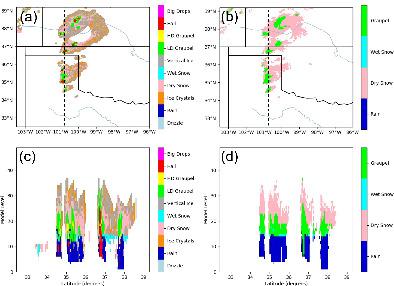当前位置:
X-MOL 学术
›
Q. J. R. Meteorol. Soc.
›
论文详情
Our official English website, www.x-mol.net, welcomes your feedback! (Note: you will need to create a separate account there.)
Radar reflectivity data assimilation method based on background-dependent hydrometeor retrieval: Comparison with direct assimilation for real cases
Quarterly Journal of the Royal Meteorological Society ( IF 8.9 ) Pub Date : 2021-03-27 , DOI: 10.1002/qj.4031 Haiqin Chen 1, 2, 3, 4 , Jidong Gao 3 , Yunheng Wang 3, 4 , Yaodeng Chen 1, 2 , Tao Sun 1, 2 , Jacob Carlin 3, 4 , Yu Zheng 5
Quarterly Journal of the Royal Meteorological Society ( IF 8.9 ) Pub Date : 2021-03-27 , DOI: 10.1002/qj.4031 Haiqin Chen 1, 2, 3, 4 , Jidong Gao 3 , Yunheng Wang 3, 4 , Yaodeng Chen 1, 2 , Tao Sun 1, 2 , Jacob Carlin 3, 4 , Yu Zheng 5
Affiliation

|
Assimilating radar reflectivity into NWP models is one of the keys to improve the accuracy of convective-scale numerical weather prediction (NWP). There are generally two major branches of research in radar reflectivity assimilation: directly assimilating radar reflectivity, and indirectly assimilating reflectivity, i.e. assimilating hydrometeors retrieved from radar reflectivity. In this study, the indirect assimilation method based on background-dependent hydrometeor retrievals is compared with the direct assimilation method using frequent data assimilation cycles for five real data cases. The retrieved hydrometeors in the indirect assimilation method are first verified against the hydrometeor types obtained from a polarimetric hydrometeor classification method. It is illustrated that the background-dependent hydrometeor retrieval method can obtain reasonable model-equivalent hydrometeors from radar reflectivity. The analysis increments for hydrometeors with both radar data assimilation methods show similar patterns but their magnitudes are different. Both quantitative and qualitative evaluations of forecasted composite reflectivities and accumulated precipitation indicate that the indirect assimilation method predicts the location and intensity of the simulated convection more accurately than the direct method. Furthermore, the indirect assimilation method is more efficient, which is valuable in real-time applications by helping deliver forecasts quickly and thus helping forecasters make more timely warning decisions.
中文翻译:

基于背景相关水凝物反演的雷达反射率数据同化方法:与实际情况下的直接同化比较
将雷达反射率同化到 NWP 模型中是提高对流尺度数值天气预报 (NWP) 精度的关键之一。雷达反射率同化一般有两个主要研究分支:直接同化雷达反射率和间接同化反射率,即同化从雷达反射率反演的水凝物。在本研究中,基于背景相关水凝物反演的间接同化方法与使用频繁数据同化周期的直接同化方法进行了比较,用于五个真实数据案例。在间接同化方法中检索到的水凝物首先根据从极化水凝物分类方法中获得的水凝物类型进行验证。说明背景相关水凝物反演方法可以从雷达反射率中获得合理的模型等效水凝物。两种雷达数据同化方法对水凝物的分析增量显示出相似的模式,但它们的大小不同。预测的复合反射率和累积降水的定量和定性评估表明,间接同化方法比直接方法更准确地预测模拟对流的位置和强度。此外,间接同化方法更有效,这在实时应用中很有价值,有助于快速提供预报,从而帮助预报员做出更及时的预警决策。两种雷达数据同化方法对水凝物的分析增量显示出相似的模式,但它们的大小不同。预测的复合反射率和累积降水的定量和定性评估表明,间接同化方法比直接方法更准确地预测模拟对流的位置和强度。此外,间接同化方法更有效,这在实时应用中很有价值,有助于快速提供预报,从而帮助预报员做出更及时的预警决策。两种雷达数据同化方法对水凝物的分析增量显示出相似的模式,但它们的大小不同。预测的复合反射率和累积降水的定量和定性评估表明,间接同化方法比直接方法更准确地预测模拟对流的位置和强度。此外,间接同化方法更有效,这在实时应用中很有价值,有助于快速提供预报,从而帮助预报员做出更及时的预警决策。预测的复合反射率和累积降水的定量和定性评估表明,间接同化方法比直接方法更准确地预测模拟对流的位置和强度。此外,间接同化方法更有效,这在实时应用中很有价值,有助于快速提供预报,从而帮助预报员做出更及时的预警决策。预测的复合反射率和累积降水的定量和定性评估表明,间接同化方法比直接方法更准确地预测模拟对流的位置和强度。此外,间接同化方法更有效,这在实时应用中很有价值,有助于快速提供预报,从而帮助预报员做出更及时的预警决策。
更新日期:2021-06-03
中文翻译:

基于背景相关水凝物反演的雷达反射率数据同化方法:与实际情况下的直接同化比较
将雷达反射率同化到 NWP 模型中是提高对流尺度数值天气预报 (NWP) 精度的关键之一。雷达反射率同化一般有两个主要研究分支:直接同化雷达反射率和间接同化反射率,即同化从雷达反射率反演的水凝物。在本研究中,基于背景相关水凝物反演的间接同化方法与使用频繁数据同化周期的直接同化方法进行了比较,用于五个真实数据案例。在间接同化方法中检索到的水凝物首先根据从极化水凝物分类方法中获得的水凝物类型进行验证。说明背景相关水凝物反演方法可以从雷达反射率中获得合理的模型等效水凝物。两种雷达数据同化方法对水凝物的分析增量显示出相似的模式,但它们的大小不同。预测的复合反射率和累积降水的定量和定性评估表明,间接同化方法比直接方法更准确地预测模拟对流的位置和强度。此外,间接同化方法更有效,这在实时应用中很有价值,有助于快速提供预报,从而帮助预报员做出更及时的预警决策。两种雷达数据同化方法对水凝物的分析增量显示出相似的模式,但它们的大小不同。预测的复合反射率和累积降水的定量和定性评估表明,间接同化方法比直接方法更准确地预测模拟对流的位置和强度。此外,间接同化方法更有效,这在实时应用中很有价值,有助于快速提供预报,从而帮助预报员做出更及时的预警决策。两种雷达数据同化方法对水凝物的分析增量显示出相似的模式,但它们的大小不同。预测的复合反射率和累积降水的定量和定性评估表明,间接同化方法比直接方法更准确地预测模拟对流的位置和强度。此外,间接同化方法更有效,这在实时应用中很有价值,有助于快速提供预报,从而帮助预报员做出更及时的预警决策。预测的复合反射率和累积降水的定量和定性评估表明,间接同化方法比直接方法更准确地预测模拟对流的位置和强度。此外,间接同化方法更有效,这在实时应用中很有价值,有助于快速提供预报,从而帮助预报员做出更及时的预警决策。预测的复合反射率和累积降水的定量和定性评估表明,间接同化方法比直接方法更准确地预测模拟对流的位置和强度。此外,间接同化方法更有效,这在实时应用中很有价值,有助于快速提供预报,从而帮助预报员做出更及时的预警决策。

























 京公网安备 11010802027423号
京公网安备 11010802027423号